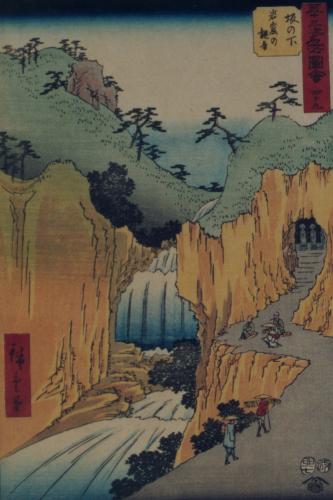Ukiyo-e
dal 14/7/2004 al 29/8/2004
Segnalato da
14/7/2004
Ukiyo-e
University Museum and Art Gallery - UMAG, Hong Kong
Ukiyo-e literally means 'pictures of the floating world'. It originated in the culture of the metropolitan city of Edo (Tokyo) during the Edo period (1603-1867) in Japan, when political and military power was in the hands of the shoguns. This exhibition features approximately 30 woodblock prints by over ten Japanese Ukiyo-e artists, including Harunobu Suzuki (1725-1770), Utamaro Kitagawa (1750-1806), Eishi Hosoda (1756-1829), Toyokuni Utagawa (1769-1825), Kunisada Utagawa (1786-1864), Hiroshige Ando (1797-1858), Kuniyoshi Utagawa (1798-1861), Hiroshige II (1826-1869), Yoshitoshi Tsukioka (1839-1892) and Fukugoshi (b. 1902).

Pictures of the Floating World
Ukiyo-e literally means "pictures of the floating world". It originated in
the culture of the metropolitan city of Edo (Tokyo) during the Edo period
(1603-1867) in Japan, when political and military power was in the hands of
the shoguns. The term "floating world" (ukiyo) was originally a Buddhist
term referring to the transcient pleasures of life. Buddhism, however, was
suppressed in the Edo period and in the late 17th century the term was used
to refer to the culture of the licensed pleasure district of Yoshiwara.
Ukiyo-e today refers mainly to the folk paintings and woodblock prints
produced from the 17th to 19th centuries.
This exhibition features approximately 30 woodblock prints by over ten
Japanese Ukiyo-e artists, including Harunobu Suzuki (1725-1770), Utamaro
Kitagawa (1750-1806), Eishi Hosoda (1756-1829), Toyokuni Utagawa
(1769-1825), Kunisada Utagawa (1786-1864), Hiroshige Ando (1797-1858),
Kuniyoshi Utagawa (1798-1861), Hiroshige II (1826-1869), Yoshitoshi Tsukioka
(1839-1892) and Fukugoshi (b. 1902). These works are all on loan from a
local collector.
Ukiyo-e normally depict secular scenes, focusing on the culture of the
"floating world" such as Kabuki theatre, courtesans and scenes of daily
life. It is a graphic art closely connected with the theatrical art,
architecture, history, and culture of Japan. As travel became an
increasingly popular pastime, the pleasures to be found in nature,
interesting landmarks, and travel are also highlighted in Ukiyo-e landscape
prints, as shown in some of the exhibits.
Ukiyo-e were also influential in developments occurring in Western art in
the late 19th century. Through diplomatic and trade exchanges, Ukiyo-e were
introduced to western audiences inspiring artists of the Impressionist and
Post-Impressionist schools eagerly seeking alternatives to the European
convention. The Utagawa School of Ukiyo-e, represented by Hiroshige whose
landscapes show an intimate and poetic atmosphere, were particularly
influential. Artists such as Van Gogh, Monet, Manet and Gauguin are known
for producing exotic works with the dramatic compositions and bold colours
of Ukiyo-e. In the decorative arts, the "Art Nouveau" and "Art Deco"
movements fashionable in Europe and the United States were also influenced
by the mood of "Japonisme" at the time. International recognition of
Ukiyo-e has elevated it to the status of fine art.
The Museum opening hours are Monday to Saturday 9:30 a.m. to 6:00 p.m.;
Sundays 1:30 to 5:30 p.m. The Museum is closed on public holidays. Admission
is free.
For additional information or photographs, please call 2241 5512 or visit
the Museum's website
IMAGE:
Hiroshige Ando (1797-1858)
Travellers at Sakanoshita Pass
53 stages of Tokaido, 49th view
July 1885
Woodblock print
(private collection)
University Museum and Art Gallery
The University of Hong Kong
94 Bonham Road, Pokfulam, Hong Kong



